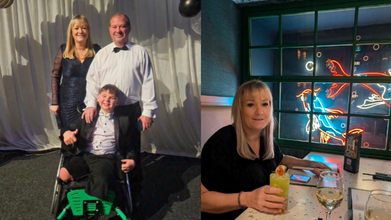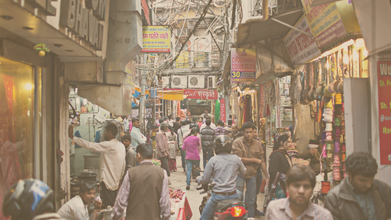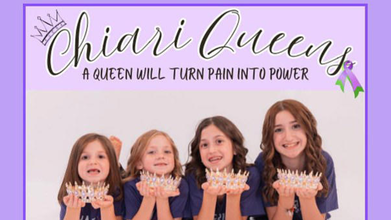- Health Conditions A-Z
- Health & Wellness
- Nutrition
- Fitness
- Health News
- Ayurveda
- Videos
- Medicine A-Z
- Parenting
- Web Stories
'Doctor Missed My Cancer 14 Times': 58-year-old Paula Hudgell, Now Battling Terminal Cancer

Credits: Instagram
If you remember Tony's Law, a legislation which formed part of the Police, Crime, and Sentencing Act 2022 after it received royal assent, all thanks to Paula Hudgell, from Kings Hill. For those uninitiated, she adopted Tony Hudgell, a 7-year-old child, who was abused by his birth parents, so severely that she had to get his legs amputated. This is what led Paula to campaign for Tony's Law to increase the sentence for child abusers from 14 years to life.
While Paula is no stranger to overcoming challenges, she faces a new challenge with her degrading health. Now 58, she is battling terminal cancer, reported the Mirror.
What breaks her heart is that Tony, who is now 11, also expresses his concern about her health to his teacher. "Life has been so tough for Tony but he never, ever complains so it breaks my heart to know he has approached his teachers at schools a few times to say he's 'worried about mummy'."
Discovering Stage 4 Cancer
She discovered that she had stage 4 terminal cancer in June and that her cancer had metastasised to her lungs and peritoneal. She also said that she was diagnosed 14 times over 4 years, to finally get to the diagnosis. The Daily Star reports that doctors had missed her cancer 14 times.
She says, "My prognosis has affected the entire family's mental health. It is hard for all of us to get our heads around, but I am trying to prepare them as much as possible. I was on the school run with Tony last week and he turned the radio up, because there was a love song playing that he liked. He told me he was going to have it at his wedding. It suddenly hit me that I won't be at his wedding. I had my tears from him but it hurts so much that I won't see him grow up or get married. I am just devastated for him and all of my children. It shouldn't have been like this."
Paula was initially diagnosed with bowel cancer in February 2022. The diagnosis happened when she first consulted a GP after she experienced episodes of diarrhea and constipation. However, she was informed that she had IBS and was discharged. It took her 14 visits to the GPs, only to be dismissed with dietary advice, antacid prescriptions, or attributions to menopause.
"I knew something wasn't right, so I made an appointment with the GP, but was told it was IBS. I kept going back, but my symptoms would last for three or four weeks and then settle down, so I thought maybe the GPs were right.
I got used to my symptoms, but then, after four years, I was on the loo and it was almost like my late mum spoke to me and I called the GP with the grit I'd have used if one of the kids was ill and said 'I need an appointment today.' I went with a different attitude and wouldn't take no for an answer. I'd started seeing the bowel cancer adverts on TV and demanded they test a stool sample. I knew deep down something was wrong, but I was so busy being a mum I put my problems on the back burner," she said.
When the results came out, her cancer markers were "through the rood" and two weeks later, she was diagnosed with advanced bowel cancer. The delay in diagnosis is what allowed the tumor to grow through the bowel wall.
While she underwent a six-hour surgery, and chemotherapy, her complications arose as her bowel blocked twice. This required further surgical intervention and the change in location where the bowel had been sectioned. Amid this, her husband was also diagnosed with prostate cancer, however, his treatment was effective and was declared cancer free this year.
Think You’re Safe Indoors? Study Says Delhi’s Winter Pollution Follows You Home

Credits: Canva
With Delhi winters coming in, the spell of late smog is most likely to stay not just outside the homes, but it could in fact, follow you inside your homes. A study by the University of Delhi's Satyawati College, Jamia Millia Islamia, and US's South Dakota University, reveal that bacterial levels were recorded to be 10 fold higher than the World Health Organization (WHO) recommended safety limits.
Studies have also found that air inside the city homes have 12 times more fungal spokes than the WHO safety limits. They can cause skin allergies, respiratory issues, and anxiety. As per a 2021 study by the Energy Policy Institute at the University of Chicago (EPIC India), PM 2.5 levels for low-income and high-income households in Delhi were high during the winters. The concentrations reported 23 and 29 times higher than the WHO safe limits, respectively. These findings also suggested that high-income households were 13 times more likely to own air purifiers than low-income households.
In Delhi, No One Gets To Breathe
Dr Kenneth Lee, who was the lead author of the study said, "In Delhi, the bottom line is - whether someone is rich or poor, no one gets to breathe clean air."
Lee further adds, "It’s a complex vicious cycle. When you do not know about the pollution levels inside your homes, you do not worry about it, and hence you are less likely to take corrective actions. Only with increased awareness, demand for clean air may gain momentum.”
The study also found that indoor PM2.5 levels were higher than the value reported by the nearest government monitor. The PM2.5 levels spiked in the mornings and evenings when households were most likely to be cooking.
The recent study published in Frontiers in Public Health 2025 notes that long term exposure to high fungal and bacterial concentration make indoor air in several parts of Delhi as harmful as the smog outside. The study also noted that most fungal particles were smaller than 2.5 microns, this is why they can easily penetrate through your bloodstreams.
The study revealed a distinct seasonal trend in indoor air quality across Delhi. Fungal levels rose steadily from winter, peaking at around 6,050 CFU per cubic metre between September and November, just before the city’s infamous smog season. Bacterial concentrations, meanwhile, climbed from winter to summer, reaching their highest levels in August before tapering off in the fall.
Health complaints among residents were widespread: 33% reported frequent headaches, 23% experienced burning or irritated eyes, 22% suffered persistent coughing or breathlessness, and 18% struggled with sneezing and allergic rhinitis. Another 15% reported skin irritation and itching.
Who Are At Most Risk Of Indoor Pollution?
The study highlighted that children and young adults were particularly vulnerable, about 28% of children under 12 and 25% of young adults (18–30 years) experienced breathing difficulties, coughing, or allergy-related symptoms. Researchers attributed children’s higher susceptibility to developing lungs, increased physical activity, and longer indoor exposure.
Women also reported more eye and skin problems, making up nearly 60% of dermatological and eye irritation cases, likely due to spending more time indoors.
Conducted over a year in North Delhi, the study, “Microbial Indoor Air Quality Assessment and Health Correlations in Densely Populated Urban Areas of Delhi, India”, found that fungal and bacterial levels inside homes were several times higher than WHO’s safe limits, underscoring that Delhi’s pollution crisis extends well beyond outdoor air.
Fact Check: Does Moon Really Affect Your Sleep And Mental Health? Here's What A Neurologist Says

Credits: Canva
You must have heard many people saying that moon disrupts your sleep cycle, and mental health. But, is there really any truth in that? Neurologist Joanna Fong-Isariawongse, who specializes in sleep medicine and how sleep affects brain writes for Scient Alert that yes, the moon affects sleep, however, its impact on mental health could be "much less certain".
The conventional belief is that moon bears an impact on people's mood and behavior, in fact, the term 'lunacy', comes from the word 'luna', which is Latin for Moon.
How Does Moon Impact Your Sleep?
There are studies, notes Joanna, that show that people sleep differently in the days that lead up to full moon. This is when the moon shines brightest. As per a 2013 study, titled 'Evidence that the Lunar Cycle Influences Human Sleep', notes that people sleep 20 minutes less, take longer to fall asleep and another 2014 study published in journal Sleep Medicine show that they even spend less time in deep, restorative sleep.
Another 2021 study, published in the journal Neurophysiology, people across different cultures tend to go to bed later and sleep for shorter periods in the nights before a full moon.
Why does this happen? The answer is in the light. The bright moon, says the neurologist, could delay the body's internal clock and reduce melatonin. Melatonin is the hormones that is responsible for signaling bedtime. This is why the brain stays more alert.
Most people lose 15 to 30 minutes of sleep, notes Joanna, however, this is measurable. This change is noticed strongest in places without artificial light, for instance in rural areas or while camping.
There are several research that also suggests that moon can impact differently to women. Joanna notes, that men seem to lose more sleep during the waxing period, while women experience less deep and restful sleep around the full moon.
Is There A Link Of Moon And Mental Health?
There are folklores that suggest that full moon could spark bipolar disorder, provoke seizures in people with epilepsy, or even trigger psychosis in those with schizophrenia. However, the logic is simple, notes Joanna. This is because people lose sleep under a bright moon and it makes their mind more vulnerable.
Research too says that sleep loss itself is a powerful reason for mental health issues. A 3034 study published by the Sleep Research Society notes that just one rough night could increase anxiety and drag down one's mood. There are also evidence that show that ongoing sleep disruption could raise one's risk of depression, suicidal thoughts, and flare-up conditions like bipolar disorder or schizophrenia.
This means even if you lose just 15 to 30 minutes of sleep during a full moon, you could be at risk.
However, notes Joanna, that when researchers look at the same theory at large groups of people, the evidence is weak. There are no reliable patterns found between the moon and hospital admissions, discharges, or lengths of stay.
However, there are other studies that may suggest small effects. For instance, in India, psychiatric hospitals record more use of restraints, as noted in the 2021 study published in The Journal of Biological and Medical Rhythm Research, during full moons. This is based on the data collected between 2016 and 2017. Another study done in 2019, published in the same journal show that in China, there was a slight rise in schizophrenia admissions around the full moon. The study used hospital data from 2012 to 2017.
Joanna asks an important question: "If the science is so inconclusive, why do so many people believe in the 'full moon effect?'" The answer is, the psychologists point to this as the illusory correlation, we may notice something unusual that coincides with a full moon, and forget that there may have been many full moon nights when nothing happened. Lastly, she writes, that moon is also highly visible, unlike the other sleep disruptors like stress, caffeine, or scrolling on phone, which is why it becomes easy to blame.
Four Sisters From The Same Family Diagnosed With The Same Rare Brain Condition, All With Weird And Mysterious Symptoms

Credits: Facebook
Heard of mysterious diseases? But have you heard of a disease so rare, and yet is diagnosed among all the siblings. This is what happened with a family in West Virginia, who were left in shock when four sisters from the same family were diagnosed with the same rare brain condition, all one after another.
Paul and Ashlee Higginbotham, the parents, were shocked to know that their youngest daughter, who was just 18 months old, was diagnosed with Chiari malformation, a rare brain condition.
However, what followed was no less than a nightmare. Out of six children, four of their daughters had the same diagnoses.
What Is Chiari Malformation?
It is a rare brain condition that occurs when the lower part of the brain does not fit inside the skull. What happens in such a situation is that the brain bulges out of the opening between the skull and the spinal cord.
Only 1 in every 2,000 people are born with malformation. However, the cause is not yet known. This condition could cause headaches, neck pain, dizziness, and difficulty with balance. It is most often congenital but can be acquired, and treatment depends on its type and severity, ranging from monitoring to medication, or even surgery.
Dr David Harter, who is the director of pediatric neurosurgery at NYO Langone told CBS News that this condition puts pressure on brain and spinal cord that causes these aforementioned symptoms. Along with those, it could also cause weakness of the limbs, difficulty breathing, scoliosis, and even nerve pain.
This condition, if left untreated, could cause lifelong pain, paralysis, and nerve damage.
How Did The Parents Know About Their Daughter's Rare Brain Condition?
Their youngest daughter Austyn was diagnosed with this condition after her parents noticed her off behavior. The conditions, as Ashlee, the mother explains were, that her daughter was "never content...never smiling, never laughing" and also had mild developmental delays and a tremor.
Genetic testing made it possible for Austyn to be diagnosed with the rare condition and it was also found that she have had severe compression in her spine and a spinal fluid blockage.
"The moment when Austyn's MRI results came up on my screen and we read the diagnosis of Chiari malformation, that was the moment our world was flipped upside down," said Ashlee.
The family travelled all the way to New York City to get Austyn a brain surgery. However, Dr Jeffrey Greenfield, who is a pediatric neurosurgeon at New York Presbyterian Hospital said that surgeons can only remove some of the bone, and the procedure is intended to allow the brain more space and restore flow of spinal fluid.
How Did The Brain Surgery Impact Austyn?
The surgery that happened in March 2023, changed Austyn. Ashlee said that her daughter woke up "ready to go". She also tried to get out of the bed, to walk, and was also "smiley". Ashlee said, "It was like the pain she would always felt was gone, and the pain of surgery did not match what she would always felt."
She told Dr Greenfield, "She was just ready to run lapse around the ICU. You gave me her laugh."
The 3 Other Daughters And Their Diagnosis Of This Rare Brain Condition
However, the parents soon noticed that even their three-year-old daughter Amelia had the same brain condition. Her imaging revealed that she had a tethered spinal cord, which is seen in about 5% of patients who are diagnosed with Chiari malformation. She also underwent a surgery in October 2023, where her tethered spinal cord was snipped. While she recovered quickly, the 7-year-old daughter Aubrey too was diagnosed with the same. The diagnosis also came after the parents noticed how moody she was becoming and that she would often get a UTI.
Aubrey also underwent a surgery in November 2023, and she too recovered quickly. This is when their 11-year-old Adalee began experiencing severe leg pain, which had worsened over the years, and she too was diagnosed with the same.
"It was such a blur of 'You have got to be kidding'," said Ashlee. However, there is an explanation. Dr Greenfield says that about 10% of these cases are genetically linked. Adalee too underwent her surgery. After four such diagnoses, the Higginbotham's two eldest children were also screened, but did not have the condition.
"[Dr Greenfield] gave us out family back, and that is the most amazing gift anyone could get," said Ashlee.
© 2024 Bennett, Coleman & Company Limited

